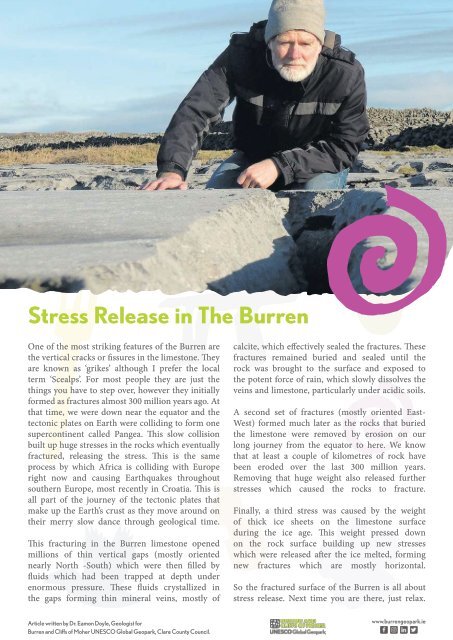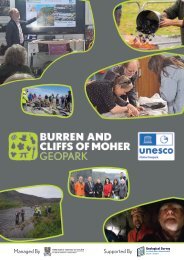Burren and Cliffs of Moher UNESCO Global Geopark - Geology
A collection of articles about the geology in the Burren and Cliffs of Moher UNESCO Global Geopark written by Dr Eamon Doyle - Geopark Geologist
A collection of articles about the geology in the Burren and Cliffs of Moher UNESCO Global Geopark written by Dr Eamon Doyle - Geopark Geologist
You also want an ePaper? Increase the reach of your titles
YUMPU automatically turns print PDFs into web optimized ePapers that Google loves.
Stress Release in The <strong>Burren</strong><br />
One <strong>of</strong> the most striking features <strong>of</strong> the <strong>Burren</strong> are<br />
the vertical cracks or fissures in the limestone. They<br />
are known as ‘grikes’ although I prefer the local<br />
term ‘Scealps’. For most people they are just the<br />
things you have to step over, however they initially<br />
formed as fractures almost 300 million years ago. At<br />
that time, we were down near the equator <strong>and</strong> the<br />
tectonic plates on Earth were colliding to form one<br />
supercontinent called Pangea. This slow collision<br />
built up huge stresses in the rocks which eventually<br />
fractured, releasing the stress. This is the same<br />
process by which Africa is colliding with Europe<br />
right now <strong>and</strong> causing Earthquakes throughout<br />
southern Europe, most recently in Croatia. This is<br />
all part <strong>of</strong> the journey <strong>of</strong> the tectonic plates that<br />
make up the Earth’s crust as they move around on<br />
their merry slow dance through geological time.<br />
This fracturing in the <strong>Burren</strong> limestone opened<br />
millions <strong>of</strong> thin vertical gaps (mostly oriented<br />
nearly North -South) which were then filled by<br />
fluids which had been trapped at depth under<br />
enormous pressure. These fluids crystallized in<br />
the gaps forming thin mineral veins, mostly <strong>of</strong><br />
calcite, which effectively sealed the fractures. These<br />
fractures remained buried <strong>and</strong> sealed until the<br />
rock was brought to the surface <strong>and</strong> exposed to<br />
the potent force <strong>of</strong> rain, which slowly dissolves the<br />
veins <strong>and</strong> limestone, particularly under acidic soils.<br />
A second set <strong>of</strong> fractures (mostly oriented East-<br />
West) formed much later as the rocks that buried<br />
the limestone were removed by erosion on our<br />
long journey from the equator to here. We know<br />
that at least a couple <strong>of</strong> kilometres <strong>of</strong> rock have<br />
been eroded over the last 300 million years.<br />
Removing that huge weight also released further<br />
stresses which caused the rocks to fracture.<br />
Finally, a third stress was caused by the weight<br />
<strong>of</strong> thick ice sheets on the limestone surface<br />
during the ice age. This weight pressed down<br />
on the rock surface building up new stresses<br />
which were released after the ice melted, forming<br />
new fractures which are mostly horizontal.<br />
So the fractured surface <strong>of</strong> the <strong>Burren</strong> is all about<br />
stress release. Next time you are there, just relax.<br />
Article written by Dr. Eamon Doyle, Geologist for<br />
<strong>Burren</strong> <strong>and</strong> <strong>Cliffs</strong> <strong>of</strong> <strong>Moher</strong> <strong>UNESCO</strong> <strong>Global</strong> <strong>Geopark</strong>, Clare County Council.<br />
www.burrengeopark.ie


















